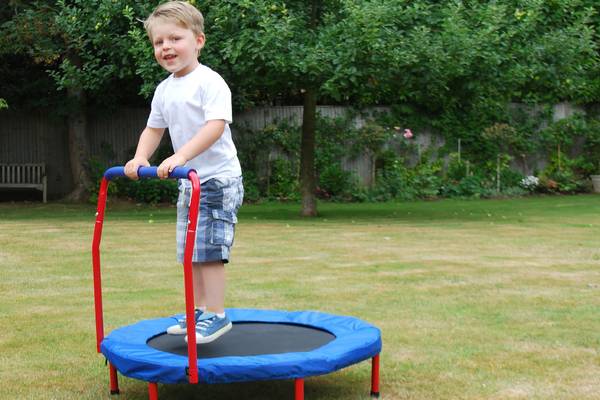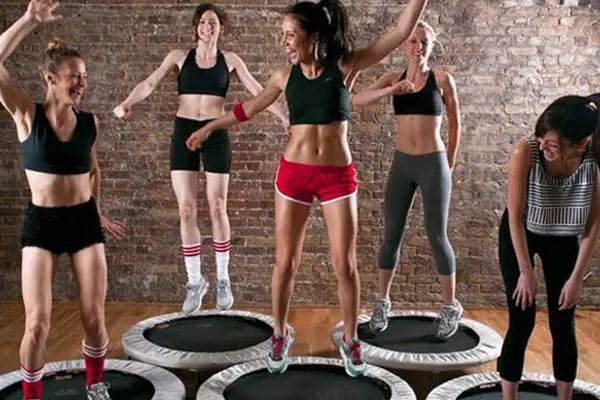There is a lot of debate surrounding trampoline and autism. Some people believe that trampoline can be helpful for autistic people while others believe that it can be harmful. There is no definitive answer, but there are some things to consider when making a decision about whether or not to allow an autistic person to use a trampoline.
One thing to consider is the safety of the activity. Trampoline can be safe if precautions are taken, but there is always a risk of injury. Another thing to consider is the sensory input that comes from bouncing on a trampoline.
For some autistic people, this input can be overwhelming and lead to anxiety or meltdowns. It’s important to weigh the pros and cons of trampoline before making a decision about whether or not it’s right for an autistic person in your life.
There is a lot of debate over whether or not trampoline is good for people with autism. While there are some benefits to using a trampoline, such as improving coordination and balance, there are also some risks that need to be considered. One of the biggest concerns is that people with autism can become easily agitated and may injure themselves or others if they are not careful.
Benefits of a trampoline for kids with Autism.
Best Trampoline for Autistic Child
There are many benefits to using a trampoline for autistic children. A trampoline can provide vestibular input, which is important for helping to develop a child’s sense of balance and spatial awareness. Additionally, the rhythmic bouncing motion can help to soothe and calm an autistic child.
When choosing a trampoline for an autistic child, it is important to consider the following factors: size, weight limit, safety features, and price. For example, a mini trampoline might be a good choice for a younger child or one who is on the smaller side. Older children or those who are taller might prefer a full-sized trampoline.
It is also important to make sure that the trampoline has adequate safety features, such as padding around the frame and springs. Finally, be sure to compare prices before making your purchase – some trampolines can be quite expensive!
Trampoline Therapy for Autism
Trampoline therapy is a type of physical therapy that uses a trampoline to help people with autism improve their motor skills and coordination. The therapist will create an individualized program for each patient based on their needs. Trampoline therapy has been shown to be effective in improving fine and gross motor skills, as well as social skills and communication abilities.
Benefits of Trampoline for Adhd
There are many benefits of trampoline for those with ADHD. Trampoline can provide a safe outlet for excess energy, help improve coordination and balance, and provide an opportunity for social interaction. Additionally, trampoline can help build self-esteem and confidence.
Trampoline for Sensory Processing Disorder
If you have a child with sensory processing disorder, you know how difficult it can be to find activities that are both fun and therapeutic. That’s why trampolines are such a great option! Not only do they provide the vestibular input that many kids with SPD need, but they’re also tons of fun.
There are a few things to keep in mind when choosing a trampoline for your child. First, consider the size of the trampoline. If your child is on the smaller side, you’ll want to choose a mini trampoline.
For older kids or adults, a standard size trampoline is probably best. Second, think about where you’ll be using the trampoline. If you have limited space, an indoor mini trampoline might be your best bet.
But if you have more room to work with, an outdoor standard size trampoline might be more fun (and offer more benefits).
Finally, consider what kind of surface you want your child to bounce on. Some parents prefer softer surfaces like grass or sand; others prefer harder surfaces like concrete or asphalt.
There are pros and cons to both options – it really just depends on what your child prefers (and what’s available in your area).
No matter what kind of trampoline you choose, make sure to supervise your child while they’re bouncing. And don’t forget – have fun!
Trampoline Sensory Benefits
Most people think of trampolines as a fun way to get some exercise, but did you know that they can also provide some great sensory benefits? If you or your child has sensory processing disorder, jumping on a trampoline can help to improve symptoms.
Here are just a few ways that trampoline jumping can help:
1. Proprioceptive input – This is the sense of knowing where your body is in space. Jumping on a trampoline helps to provide this type of input and can be especially helpful for those who have trouble with balance and coordination.
2. Vestibular input – This is the sense of movement and helps with things like balance and orientation.
Again, jumping on a trampoline provides this type of input and can help to improve symptoms related to vestibular processing disorder.
3. Tactile input – Touch is an important sense that helps us understand the world around us. The pressure from jumping on the trampoline provides tactile input which can be calming for those who are oversensitive to touch or have trouble processing information from their skin receptors.
4. Visual input – For those who have trouble with visual processing, the constant movement while jumping on a trampoline can help to stimulate the visual system and make it easier to process information correctly.
Benefits of Trampoline for Toddlers
Trampoline for toddlers can be a great way to improve their gross motor skills and coordination. It can also help them develop balance and strength. Additionally, trampoline for toddlers can provide an outlet for energy and help them burn off excess calories.
Trampoline Benefits
There are many benefits to using a trampoline, both for physical and mental health. Trampolining can help improve coordination and balance, increase bone density and muscle strength, improve cardiovascular fitness and circulation, reduce stress levels, and much more. Here are just a few of the many benefits that you can experience by incorporating trampolining into your workout routine:
1. Improves Coordination & Balance
One of the best benefits of trampoline exercise is that it helps improve your coordination and balance. Because you have to constantly adjust your body position while bouncing on the trampoline, your brain gets better at sending signals to your muscles in order to keep you upright and stable.
This improved coordination can carry over into other areas of your life such as sports or everyday activities.
2. Increases Bone Density & Muscle Strength
Another great benefit of trampoline exercise is that it helps increase bone density and muscle strength.
The constant impact when jumping up and down strengthens bones and muscles throughout the entire body, including the legs, hips, back, arms, shoulders, and core. This increased muscle strength can help improve athletic performance as well as reduce the risk of injuries in everyday life.
3. Improves Cardiovascular Fitness & Circulation
In addition to improving coordination and balance, trampoline exercise also helps improve cardiovascular fitness and circulation. The constant bouncing motion gets your heart pumping faster which leads to increased blood flow throughout the body. This increased blood flow delivers more oxygen to muscles which helps them work more efficiently during exercise (or any physical activity).
Additionally, this improved circulation can help reduce blood pressure levels overall which is beneficial for long-term health.
Trampoline And Brain Development
As a parent, you may be wondering if trampolines are safe for your child. After all, you’ve probably heard stories about children getting injured while using them. However, you may not know that there are actually many benefits to using a trampoline.
One of these benefits is that it can help with brain development.
When children use a trampoline, they are constantly jumping and moving around. This helps to improve their coordination and balance.
Additionally, the constant movement helps to stimulate the brain and can even improve cognitive function. In fact, studies have shown that children who use trampolines have better problem-solving skills than those who don’t.
So, if you’re looking for a way to help your child’s development, consider investing in a trampoline.
Just be sure to supervise them when they’re using it and make sure they follow the safety rules.

Credit: www.gettrampoline.com
Are Trampolines Good for Kids With Sensory Issues?
Most people with sensory processing issues find trampolines to be a helpful tool in managing their symptoms. The repetitive movement and deep pressure input help to “reset” the nervous system, providing a sense of calm and improved focus. Additionally, the vestibular input from bouncing can help to improve balance and coordination.
Overall, trampolines can be a great way to provide positive sensory input for kids with Sensory Processing Disorder (SPD).
Why Do Kids With Autism Like Trampolines?
There is no one answer to this question as every child with autism is different and will like different things. However, there are a few possible reasons why trampolines might be appealing to kids with autism.
First, jumping on a trampoline can be a great way to release energy and get some exercise.
This can be especially helpful for kids who have difficulty regulating their energy levels or who tend to be more sedentary. Additionally, the repetitive motions involved in jumping can be calming and help to ease anxiety or stress.
Another reason why trampolines might be appealing to kids with autism is that they can provide a sense of independence and control.
When jumping, kids can direct their own movements and feel in control of their bodies in a way that they may not always feel in other situations. Additionally, the social isolation that is often associated with autism can be alleviated when bouncing on a trampoline, as it provides an opportunity for gentle physical contact with others (if bouncing together) and eye contact (if watching others bounce).
Ultimately, every child with autism is unique and will like different things for different reasons.
However, trampolines may offer an enjoyable activity that also has some therapeutic benefits.
How Does a Trampoline Help With Sensory?
A trampoline can help with sensory processing in a few ways. The movement and vestibular input from jumping can help to organize the nervous system. The proprioceptive input from the muscles and joints also helps to provide information to the brain about where the body is in space.
The sense of touch is also stimulated when jumping on a trampoline, which can provide calming input for some people.
Are Trampolines Good for Child Development?
There is a lot of debate surrounding trampolines and whether or not they are good for child development. Some people argue that trampolines are beneficial because they help children to develop coordination, balance, and strength. Others argue that trampolines are dangerous because they can lead to injuries.
So, what is the truth? Are trampolines good or bad for child development?
The answer is that it depends.
Trampolines can be both good and bad for child development, depending on how they are used. Used properly, trampolines can help children to develop coordination, balance, and strength. However, if used improperly, trampolines can be dangerous and lead to injuries.
Here are some tips for using trampolines safely:
-Always have adult supervision when children are using a trampoline.
-Make sure thetrampoline is in a safe area away from obstacles such as trees or fences.
Conclusion
Trampoline is a great way to get some exercise for children with autism. It can help them burn off excess energy, and it is also a great way to socialize with other children.




